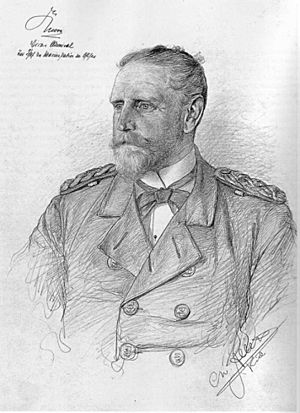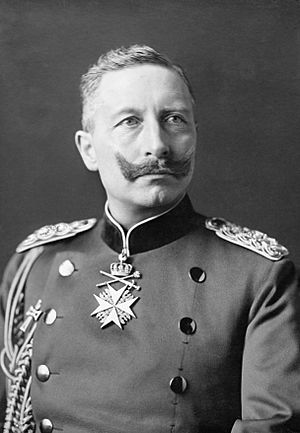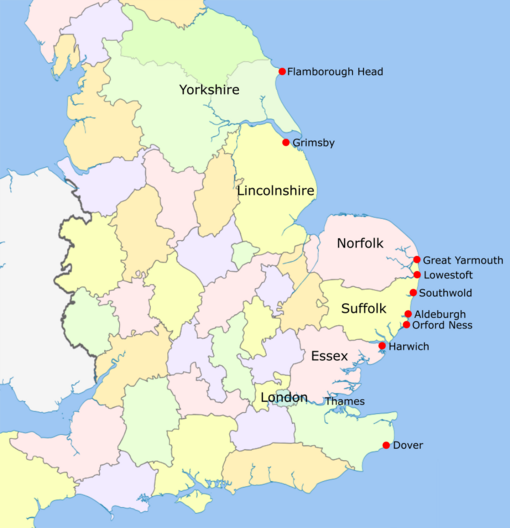Imperial German plans for the invasion of the United Kingdom facts for kids
Imagine a time when Germany planned to invade the United Kingdom! This idea first came up in 1897. Admiral Eduard von Knorr, who led the Imperial German Navy, thought of it. At this time, Germany and Britain were becoming big rivals. Germany was also building up its navy.
Admiral Knorr knew Germany's navy was small. So, his plan was to attack the Royal Navy first. This would give Germany control of the sea for a short time. Then, German troops would land quickly in Britain. They had to land before the British navy could get strong again. Later studies showed that a very short sea trip was key. This meant using ports in Belgium and the Netherlands. German planners even checked out the English east coast. They picked possible landing spots in East Anglia.
Alfred von Schlieffen, a top German army leader, thought the invasion was not possible. His team believed it would take 320,000 soldiers to beat Britain's defenses and capture London. They also knew a quick win was a must. Otherwise, the invading army would be cut off and have to give up. Admiral Alfred von Tirpitz, another important naval leader, always opposed these plans. The plans were put aside in 1899. It became clear that Germany's navy and merchant ships were not strong enough. They couldn't invade without everyone finding out, which was a big secret they needed to keep.
During the First World War, Germany only attacked the British mainland with raids. These raids were meant to make the Royal Navy spread out its ships. This would give the smaller German navy a better chance to fight them.
Contents
Why Germany Thought of Invading Britain
After becoming the German Emperor in 1888, Wilhelm II changed Germany's foreign policy. He wanted Germany to be a world leader. He stopped following the careful approach of Otto von Bismarck, a former German leader.
One example of this change was in 1896. Wilhelm II wanted Germany to get involved in a conflict in South Africa. This was after the Jameson Raid in the Transvaal. The German Foreign Secretary, Adolf Marschall von Bieberstein, convinced Wilhelm not to send soldiers. Instead, Wilhelm sent a telegram to the Transvaal leader, Paul Kruger. He congratulated Kruger for stopping the British raid. This "Kruger telegram" made relations between Britain and Germany worse. Germany then started building a bigger navy. They wanted to challenge Britain's powerful navy. Germany hoped to become the world's top power instead of the United Kingdom.
Early Invasion Ideas
As the two countries became bigger rivals, German planners started thinking about invading Britain in 1895. Admiral Eduard von Knorr gave his idea to Emperor Wilhelm in May 1897. He believed Germany's small navy could attack the Royal Navy quickly. This would happen on the fifth day of getting ready for war. Then, German troops would land right away on British shores.
Emperor Wilhelm allowed more studies. The navy's plan, called Memorandum: an Operation against Antwerp, was given to Admiral von Knorr in November. The plan said the shortest sea trip offered the best chance of success. It suggested breaking the rules of Belgium and the Netherlands. This would involve a land and sea attack at the same time. The goal was to capture Antwerp and forts along the Scheldt River.
Soldiers would land from seven ships gathered secretly at the river's mouth. At the same time, two German army groups would cross the Dutch and Belgian borders. They would move west to capture Breda and meet the sea-landed troops at Antwerp. These places in Belgium and the Netherlands would then be used to launch the invasion of Britain. This operation was to start at least 24 hours before Germany officially declared war on Britain.
It took Alfred von Schlieffen, the army's chief, six months to reply to the navy's request. This showed the army wasn't very interested. He didn't think an invasion was possible. But he did see some use in naval actions against Belgium and the Netherlands. This was part of his plan for a war against both France and Russia. A German fleet from these countries would stop the French navy from using the North Sea. He suggested Vlissingen in the Netherlands as the best port for troops. He said all available troops should be used for the invasion. He thought the Thames river mouth or areas north of it would be the best landing spots. He believed the landing should be done by the fifteenth day. It was expected that the rest of the British fleet would then arrive. This would give Britain control of the sea again. Schlieffen stressed that an invasion must force Britain to make peace quickly. Otherwise, the Royal Navy would cut off the invading army. This would make them surrender.
By late 1897, it became clear that Germany's plans were too big. The small German fleet became even weaker. Some ships were sent far away to the Far East. At the same time, Britain's Channel Squadron doubled in size. It became the strongest squadron in the world. Its eight modern ships were more than the five smaller ships of the entire German fleet. For the invasion plans to work, secrecy was vital. But Germany's capture of Kiao-Chow in China showed that preparing an invasion force secretly was impossible. The Kiao-Chow trip also showed Germany didn't have enough resources. Just sending one group of soldiers used up all of Germany's transport ships.
Admiral Alfred von Tirpitz strongly opposed the invasion plans. He became the head of the German Imperial Naval Office in June 1897. He thought von Knorr's plans were too risky. He felt an invasion couldn't happen until the German navy was strong enough to match Britain's. Planning continued in 1898. The hope was that the German fleet would one day be as strong as the Royal Navy. Studies showed it would take eight days, not five, to start landing troops. This was without preparing before war broke out. In April, the navy thought they could get 145 ships and a few army groups. But the army said in May that up to eight army groups, about 320,000 soldiers, would be needed. Even if such a large force could be spared in a war against France and Russia, it couldn't be gathered secretly. It would also take years for German ports and merchant ships to carry such a large force.
Choosing a Landing Spot
Planners carefully thought about where to land. They ruled out areas south of Dover. This was because of many defenses there. They also ruled out landing along the Thames River in March 1898. This was due to the growing strength of Dover's port defenses. Studies then focused on areas north of the Thames. These spots had good ports and were close to forts. Harwich was especially appealing. It could hold larger ships, had few nearby forts, and could be protected with mines.
German spies checked the English coast from Orford Ness, Suffolk, to Scarborough, Yorkshire. They found four good places to land. These were chosen based on how easy it was to anchor ships and reach the beaches. From north to south, they were:
- Flamborough Head, Yorkshire;
- The Humber river mouth near Grimsby, Lincolnshire;
- The East Anglian coast from Great Yarmouth, Norfolk, to Southwold, Suffolk;
- The Suffolk coast from Southwold to Orford Ness.
Army planners wanted a spot as close to London as possible. Schlieffen agreed with the navy that British coastal defenses stopped any landing south of Orford Ness. He rejected any plan to invade north of the Humber. He felt it was too far from any important target. He suggested that planning should focus on landing between Great Yarmouth and Aldeburgh, Suffolk. During the First World War, British defense planners also thought this area was the most likely invasion route.
Plans Put Aside
In January 1899, Admiral von Knorr decided that Germany could not invade Britain alone. He felt it would be impossible to gather a large transport fleet secretly. It would also be impossible to gain control of the sea. This control was needed for at least seven days to complete the landings. Army planners came to the same conclusion.
However, some interest in the plan returned during the Second Boer War. This war in South Africa forced Britain to send many soldiers away. By March 1900, only four groups of regular soldiers were left in Britain. Lieutenant-General Colmar Freiherr von der Goltz, an engineer in the German army, saw a chance. He thought Germany could gain control of the sea for a short time and invade. His plan, given in March, involved using barges pulled by tugboats to carry the invasion force. The German naval staff didn't think his idea was serious. They didn't follow up on it. But this idea was later used in a book called The Riddle of the Sands by Erskine Childers in 1903.
In 1901, Germany held several joint army and navy exercises. The biggest one involved landing 1,700 marines. A British observer was not impressed by the small number of soldiers. He thought the exercise was faked, with the defending force holding back on purpose. In the same year, a German officer wrote a paper. It described how an invading force of one cavalry and four infantry groups could live off the land. It also said how they could defeat the British army and capture London. The government stopped this paper from being shared. This showed the official military view, held by Tirpitz, that an invasion was impossible. The idea was only looked at again when Emperor Wilhelm ordered the army and navy to review a novel. This was William Le Queux's book The Invasion of 1910, which was published in a newspaper in 1906.
What Happened Later
At the start of the First World War, German spies thought Britain's coastal defenses were much stronger than they were. This led them to believe that even a big raid would be too risky for little gain. German naval attacks on the British mainland were limited to shelling coastal towns. These included Great Yarmouth on November 3, 1914, Scarborough, Hartlepool and Whitby on December 16, 1914, and Great Yarmouth and Lowestoft on April 24, 1916. The goal of these attacks was purely naval. Germany wanted to make the British public pressure the Royal Navy. They hoped this would make the British navy spread out its powerful Grand Fleet to defend the coast. This would then create a chance for the German High Seas Fleet to fight and defeat smaller parts of it.
See also
- Operation Sea Lion, Nazi Germany's plan to invade the United Kingdom during World War Two




